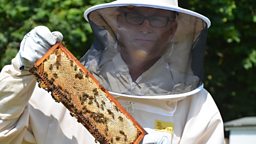Main content
The buzz about bees
From honey to the bees – learn more about the remarkable secrets of the most iconic insect of the British summer.
Four super sweet honey facts
- Worldwide, honey bees provide an annual honey crop of approximately one billion kilograms
- Each honey bee will produce about a twelfth of a teaspoon of honey in its lifetime – probably the amount left on your knife after spreading honey on your toast
- 10 million foraging trips go into making one jar of honey, a distance of up to 50,000 miles – that’s equivalent to travelling twice around the globe!
- Honey has a virtually eternal shelf-life if kept sealed and apparently honey found in the pharaohs’ tombs in Egypt was still edible after 3,000 years

It takes 10 million foraging trips to produce one jar of honey

Chris Packham learns what it takes to be a beekeeper
10 things you need to know about the honey bee
- A forager bee may visit 2,000 flowers a day to collect nectar and pollen
- The bees’ stomach is the size of a pinhead and to fill this once the bee may need to visit 100 flowers
- Bees fly at an average of 13 to 15 mph and can travel up to four miles away from their hive – sometimes more
- Bees also eat pollen and an average bee hive or colony consumes around 40 kilos a year
- A bee flaps its wings between 200 and 230 times per second when flying
- Each bee flies about 500 miles in its lifetime and if it is not eaten by a predator, the bee usually dies of exhaustion after about three weeks
- Any fertilised egg could turn into a queen rather than a worker and being fed royal jelly triggers this transformation
- Honey bee senses are impeccable: they can see ultraviolet light, have an amazing sense of smell, can detect electrical signals and the earth’s magnetic field
- Honey bees can count up to four and memorise landmarks to help them to learn where their hive is located
- The cells in a natural honey bee comb are initially circular but gradually take on the familiar hexagonal shape by a flow of the wax, which is turned semi-molten by the heat from specialist heater worker bees

Forager bees visit up to 2,000 flowers a day

An average beehive consumes 40 kilos of pollen a year
